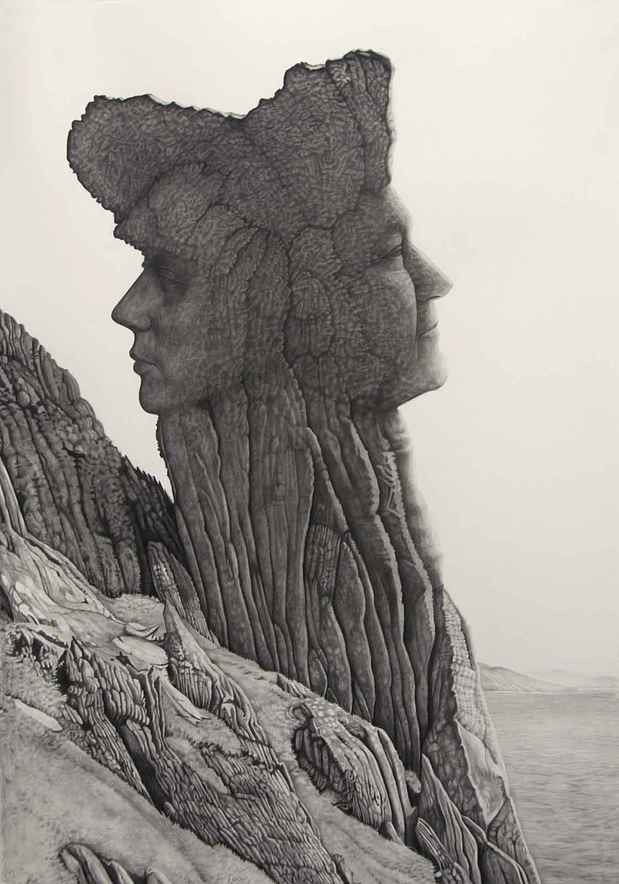"Collapse" Exhibition
RH Gallery

This event has ended.
RH Gallery presents Collapse, curated by gallery artist Micah Ganske. Collapse
draws inspiration from Jared Diamond’s book, Collapse: How Societies Choose to Fail or Succeed. In this text, Diamond hypothesizes the triggers and trajectories leading to the fall of a civilization and concludes that the true
cause of social collapse relies on a failure to adapt. Diamond states, “Societies die from suicide, not by murder.”
Although somewhat bleak, this view offers a beacon of hope: every individual has the ability to change. Ganske’s exhibition seeks to reveal the symptoms of collapse while simultaneously envisioning possible alternatives. Collapse
showcases a group of contemporary artists whose work reflect Diamond’s paradigm.
In his book, Diamond references the autoimmunity of the Easter Island culture. Easter Islanders decimated their land through the production of the renowned stone Moai heads. Heeseop Yoon’s work illustrates a portrayal of the Moai head within a contemporary setting. In drawings and wall installations, Yoon portrays mass collections of clutter including discarded technology, abandoned appliances, and other obsolete remnants of the past. These works depict hoards of garbage and the landfills where they will inevitably decay to become testaments to our culture.
An examination of the history of the relationship between humans and the earth does not reveal a noble savage at one with nature. On the contrary, our inability to visualize and plan for the long-term is evident in the widespread disappearance of mega-fauna from fossil record after our arrival. The drawings of Maximilian Toth portray a lack of foresight by depicting youth engaged in drunken mass orgies, aggressive behavior and general mischief with a lack of acknowledgment for consequences. The revelers and victims in Toth’s work represent more than an escape from reality; they stand as symbols of our culture. Their approaching regret echoes the specter of self-destruction looming over our society.
The speed at which science and technology has accelerated in the twentieth and twenty-first centuries is staggering. Our innovations have saved lives while at the same time, they constantly push limits, resulting at times in environmental catastrophes. Maria Kozak’s paintings of designer pets in the wild reference the rift between nature and scientific “innovation.”
Erick Swenson’s work Ne Plus Ultra depicts the decayed corpse of a buck covered with scrimshaw carvings. The title translates in English to “No Further Beyond”: a Latin term commonly used by early cartographers meaning “to delineate borders of unexplored territories.” This gruesome display of death and the mysterious maps carved into the animal’s bones reflect the profound loss inherent in the ubiquitous disconnect between people and nature in our society.
Diana Al-Hadid’s oeuvre is a kind of haunted architecture incorporating classical and contemporary references simultaneously yet in turns. The work contains the aura of a relic from the ancient past while alluding to possible futures. Within her atemporal forms lie the roots of societal decay.
A socio-cultural collapse often can be traced to the very foundations of a society. Therefore, avoiding total collapse requires a complete restructuring of its core mechanisms and communication systems. The dystopian paintings of Ian Davis represent a not-so-distant future in which a complete collapse has just barely been evaded.
The congregations of cloned masses and desolate landscapes recall an Orwellian society. Despite the bleak environment, people somehow continue to engage in rebuilding their communities.
Colette Robbins depicts massive, double-faced stone relics as monuments to the relationships between two people. She envisions stone sculptures carved to depict loved ones and a future where they are unearthed: becoming symbols of their culture. Robbins reminds us of the significance of these relics within our society.
Media
Schedule
from November 01, 2011 to January 13, 2012
Opening Reception on 2011-11-01 from 18:00 to 20:00